
Overview
As the world's largest engine producer, continuous improvement to vehicle powertrain technology is an integral part of Honda's engineering culture as every new engine design tends to become more powerful, efficient and cleaner while also becoming smaller in size and weight. Advancements in powertrain technology lead the way to improvements in vehicle packaging, interior space and overall desirability that give Honda products an edge in an ultra-competitive automotive industry. The 2006 Civic is no exception, and the new powertrain technology on all models delivers in true Honda fashion.
The Civic is available with three powertrains that consist of a 197-horsepower, 2.0-liter i-VTEC engine in the Civic Si; a 110-horsepower and ultra-efficient 1.3-liter i-VTEC engine with Integrated Motor Assist in the Civic Hybrid; and an innovative 140-horsepower, 1.8-liter i-VTEC engine in the Civic Sedan and Civic Coupe. The 1.8-liter i-VTEC engine provides off-the-line acceleration performance at low rpm equivalent to that of a 2.0-liter engine, and efficiency that is up to 6 percent better than the current 1.7-liter Civic engine, making it one of the world's most efficient 1.8-liter engine designs. A 6-speed manual transmission with a limited slip differential is standard in the Civic Si, a Continuously Variable Transmission (CVT) is standard in the Civic Hybrid, and the Civic Sedan and Coupe are equipped with a standard 5-speed manual or an available 5-speed automatic transmission.
Powertrain Summary
Engines
- Ultimate High Performance: 2.0-liter i-VTEC DOHC 4-cylinder engine
- 197 horsepower (1) (23 percent increase)
- 139 lb-ft. of torque (1) (5 percent increase)
- 22/31 EPA estimated city/highway fuel economy (2)
- Ultimate Economy: 1.3-liter i-VTEC SOHC 4-cylinder engine with Integrated Motor Assist
- 110 horsepower (1) (24 percent increase)
- 123 lb-ft. of torque (1) (29 percent increase)
- 49/51 EPA estimated city/highway fuel economy (2)
- Best All-Around Performer: 1.8-liter i-VTEC SOHC 4-cylinder engine
- 140 horsepower(1) (10 to 21 percent increase depending on trim level)
- 128 lb-ft. of torque(1) (12 to 16 percent increase depending on trim level)
- 30/40 EPA estimated city/highway fuel economy (5AT) (2)
(1) 2006 horsepower and torque calculations reflect new SAE J1349 procedures revised August, 2004.
(2) Fuel economy based on EPA mileage estimates. Use for comparison purposes only. Actual mileage may vary.
Transmissions
- 6-speed manual transmission with a limited slip differential (exclusive on Si)
- Continuously Variable Transmission (exclusive on Hybrid)
- 5-speed automatic transmission (available on Civic Sedan and Coupe)
- 5-speed manual transmission (standard on Civic Sedan and Coupe)
Civic Si Powertrain
The 2006 Civic Si incorporates a host of innovative features designed to deliver a cutting-edge combination of performance, fuel efficiency, and low emissions. Most apparent is the i-VTEC "intelligent" valve-control system, a technology that combines VTC (Variable Timing Control) - which continuously adjusts camshaft phase-with Variable Valve Timing and Lift Electronic Control (VTEC) - which changes valve lift, timing, and duration. Combining these two systems results in impressive horsepower and high torque with good fuel economy and low exhaust emissions.
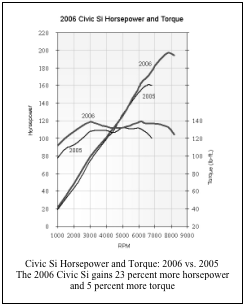 The Civic Si engine is a dual overhead cam (DOHC) all-aluminum, 2.0-liter inline four-cylinder design that uses 16 valves, a high-performance version of the i-VTEC system and a specially tuned high-volume intake manifold. The Civic Si produces 197 horsepower at 7800 rpm, up from 160 horsepower at 6500 rpm and torque increases from 132 lb-ft. at 5000 rpm to 139 lb-ft. at 6200 rpm. At nearly 100 horsepower per liter, it has one of the highest specific outputs of any production engine in the world.
The Civic Si engine is a dual overhead cam (DOHC) all-aluminum, 2.0-liter inline four-cylinder design that uses 16 valves, a high-performance version of the i-VTEC system and a specially tuned high-volume intake manifold. The Civic Si produces 197 horsepower at 7800 rpm, up from 160 horsepower at 6500 rpm and torque increases from 132 lb-ft. at 5000 rpm to 139 lb-ft. at 6200 rpm. At nearly 100 horsepower per liter, it has one of the highest specific outputs of any production engine in the world.
In keeping with Honda's proven commitment to the environment, the Civic Si engine meets strict Low Emission Vehicle-2 (LEV-2) tailpipe emissions standards. Engine, fuel tank and catalytic converter modifications made for 2006 have lowered evaporative emissions by 75 percent to achieve a LEV-2 Evaporative Emissions rating.
The Civic Si is available exclusively with a short-throw 6-speed manual transmission. The final gear ratio is a low 4.765:1 that complements the additional horsepower and provides enhanced acceleration. Designed to be compact and lightweight, the 6-speed has also been engineered to provide the lightning-quick shift action of a racecar transmission. Synchronizers (triple cone on gears 1 and 2, double cone on gears 3 and 4, and single cone carbon on gears 5 and 6) help reduce shifting load for a light, responsive feel. The Si also includes a short-throw clutch with a torsion mechanism that enhances clutch refinement in terms of engagement and feel.
Civic Si Powertrain At-A-Glance
Engine
- Aluminum block with cast-in iron liners for light weight and durability
- 16-valve DOHC i-VTEC "intelligent" valve-control system
- Lightweight alloy pistons and forged steel connecting rods (11.0:1 Compression Ratio)
- One-piece crankshaft carrier with ferrous main bearing caps for improved rigidity and durability
- High performance camshafts
- Performance-tuned intake manifold
- Drive-by-wire throttle control
- Computer-controlled Programmed Fuel Injection (PGM-FI)
- Direct Ignition System
- Chain-driven balancer unit mounted in oil pan
- Torque rod engine mount system consists of an upper and lower torque rod, a hydraulic body mount and a front beam stopper
- Maintenance Minder system
- Maintenance-free silent-chain camshaft drive
- Maintenance-free serpentine accessory drive with auto tensioner
Emissions/Fuel Economy
- Estimated EPA fuel economy of 22/31 mpg (city/highway)
- Low Emission Vehicle-2 (LEV-2) emissions
6-Speed Manual Transmission
- Exceptionally short throws for "racecar" shift feel
- Low final gear ratio for quick acceleration (4.765:1)
- Advanced clutch torsion mechanism enhances clutch engagement
- Hydraulic damper integrated with master cylinder for reduced pedal vibration
- Short clutch-pedal stroke for effortless shifting
- Advanced friction material for improved clutch operability
- Helical type limited slip differential
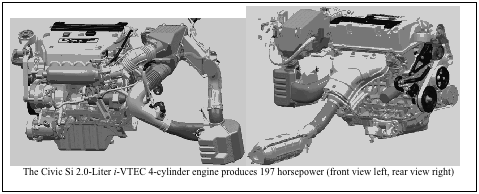
Civic Si: Engine Block/Crankshaft
The Civic Si engine features a compact aluminum block with cast-in iron liners-a design known for its lightweight, high rigidity, and excellent durability. The block has a one-piece aluminum crankshaft carrier, which has ferrous-carbon inserts in the bearing caps for additional strength and incorporates a stiff, cast-aluminum oil pan. The crankshaft is a highly rigid, forged-steel design that uses a special micro-polished surface finish for reduced friction and increased durability. In addition, the engine uses high-strength connecting rods and crankshaft as well as high-compression cast-aluminum pistons.
 Civic Si: i-VTEC Concept
Civic Si: i-VTEC Concept
The innovative Variable Valve Timing and Lift Electronic Control (VTEC) system delivers abundant low-rpm torque, exhilarating high-rpm power, and outstanding fuel efficiency. The Civic Si features the latest version of this remarkable engine system: i-VTEC. The "intelligent," i-VTEC system adds VTC (Variable Timing Control) to VTEC to provide continuously variable camshaft timing - taking the concept of variable valve timing to new heights. In the Civic Si, i-VTEC = VTEC + VTC. Not only does i-VTEC provide a substantial performance increase across a broad power band, it boosts fuel economy while also reducing engine emissions.
Civic Si: i-VTEC Valvetrain
The Civic Si engine uses an aluminum cylinder head and a dual overhead cam, four-valve-per-cylinder valvetrain incorporating the i-VTEC system. High performance camshafts are used that allow for aggressive intake and exhaust valve openings to boost the rate that air moves into and exhaust moves out of the cylinder. At high engine speeds, valve lift phase on the intake side is increased by five degrees and on the exhaust side by 10 degrees. The camshafts increase engine breathing and help deliver enhanced top-end horsepower. The camshafts are operated by a silent-chain drive that helps provide smooth, refined performance while also being maintenance-free.
The VTEC component to the innovative Civic Si i-VTEC system adjusts the lift and opening duration of the valves to help the engine produce both abundant low-rpm torque and excellent high-rpm power. At low rpm, VTEC provides valve timing and lift for optimum cylinder filling. In addition, the timing of the intake valves is staggered and their lift asymmetric-creating a swirl effect within the combustion chambers. The result is increased burn speed with improved combustion stability. As engine rpm builds, VTEC transitions to a high-lift, long-duration cam profile for improved high-rpm engine output.
 The Civic Si uses a high performance version of VTEC that varies the lift and duration of both the intake and exhaust valves for maximum power output. At lower rpm, the valves follow low lift, short duration camshaft profiles to help boost low-end torque. Above 5,800 rpm, the intake and exhaust valves are operated by high-lift, long-duration cam profiles, for maximum high rpm horsepower. When combined with VTC, both versions help the Civic Si engine produce a remarkably broad and smooth power band with exceptional torque and horsepower.
The Civic Si uses a high performance version of VTEC that varies the lift and duration of both the intake and exhaust valves for maximum power output. At lower rpm, the valves follow low lift, short duration camshaft profiles to help boost low-end torque. Above 5,800 rpm, the intake and exhaust valves are operated by high-lift, long-duration cam profiles, for maximum high rpm horsepower. When combined with VTC, both versions help the Civic Si engine produce a remarkably broad and smooth power band with exceptional torque and horsepower.
Civic Si: VTC (Variable Timing Control)
The Civic Si's i-VTEC system adds VTC (Variable Timing Control) to VTEC for continuously variable camshaft phasing across the engine's entire power band. As engine rpm builds, a VTC actuator-controlled by an engine-control unit that monitors cam position, ignition timing, exhaust oxygen content, and throttle position-advances or retards the intake cam throughout the 50 degree range, optimizing engine output and reducing emissions.
During typical operation, the intake camshaft timing is almost fully retarded at idle to help provide more stable idling while reducing exhaust emissions (NOx). As rpm increases, the intake camshaft is advanced, opening the intake valve sooner and providing additional valve overlap. This results in increased fuel economy (by reducing pumping losses) and a further reduction in exhaust emissions (by creating a large, internal exhaust gas re-circulation effect). Also, to generate additional power throughout the rev range, the intake camshaft is continuously varying the amount of advance or retard, instantly adjusting to provide additional power as required by the driver.
Civic Si: Short Length Performance Tuned Intake Manifold with High-Flow Intake
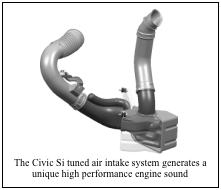 A short, high-performance single-stage cast aluminum manifold is used to help boost high-rpm power and generate a unique high performance engine sound in the Civic Si. The diameter of the intake duct measures 70 mm to increase intake flow, especially at high rpm. In addition to increasing flow, this large intake duct creates a highly pronounced sport sound under hard acceleration. Furthermore, a specially tuned resonance chamber was designed to emphasize the VTEC switch point, a unique character of many Honda vehicles. The intake duct was routed inside the fender area to take advantage of the acoustic sensitivity of the fender panel. By doing this, the desirable intake sound during high performance driving is amplified by the resonance of the fender panel.
A short, high-performance single-stage cast aluminum manifold is used to help boost high-rpm power and generate a unique high performance engine sound in the Civic Si. The diameter of the intake duct measures 70 mm to increase intake flow, especially at high rpm. In addition to increasing flow, this large intake duct creates a highly pronounced sport sound under hard acceleration. Furthermore, a specially tuned resonance chamber was designed to emphasize the VTEC switch point, a unique character of many Honda vehicles. The intake duct was routed inside the fender area to take advantage of the acoustic sensitivity of the fender panel. By doing this, the desirable intake sound during high performance driving is amplified by the resonance of the fender panel.
Civic Si: Drive-by-Wire Throttle Control
An electronic drive-by-wire system helps enhance the driving character of the Civic Si. With smart electronics connecting the throttle pedal to the throttle butterfly valve in the intake manifold, the engine response can be optimized to suit the driving conditions and to better match the driver's expectations. By eliminating the direct throttle cable connection to the engine, the ratio between pedal movement and throttle butterfly movement can be continuously optimized.
The Civic Si uses a DC motor to control the throttle butterfly position in the intake tract. To establish the current driving conditions, the system monitors pedal position, throttle position, vehicle speed, engine speed and engine vacuum. This information is then used to define the throttle control sensitivity.
Civic Si: Programmed Fuel Injection (PGM-FI)
The Civic Si is equipped with a Programmed Fuel Injection (PGM-FI) system. The system monitors throttle position, engine temperature, intake-manifold pressure, atmospheric pressure, exhaust-gas oxygen content, and intake-air temperature. It controls fuel delivery by multi-holed injectors mounted in the cast-aluminum intake manifold. The ECU also tracks the operation of the engine with position sensors on the crankshaft and both camshafts.
Civic Si: Direct Ignition System
To ensure a hot, stable spark at high rpm operation, a coil mounted atop each spark plug, helps ensure a stable spark up to 8000 rpm. A sensor mounted behind one of the camshafts is the trigger for spark plug ignition. Also, specially designed iridium-tipped spark plugs help increase ignition energy and enhance plug life.
Civic Si: Exhaust System
A stainless steel, low heat-mass exhaust system is standard on the Civic Si. The system employs a high-density catalytic converter for improved light-off performance and reduced hydrocarbons and NOx. Emissions performance is further improved thanks to the engine's design, which positions the exhaust manifold on the rear of the engine-which shortens the distance that the exhaust gases must travel to the catalytic converter, resulting in faster light-off and more complete conversion of the exhaust gases. The exhaust system also incorporates an "e-shaped" dual-path pipe that optimizes the exhaust flow for improved torque and lower emissions. By employing a large diameter tail pipe (60.5 mm), an exhaust flow of 105 liters per second is achieved.
Civic Si: Noise, Vibration and Harshness (NVH) Control
In addition to its outstanding power and response, the Civic Si engine has been engineered for class-leading smoothness and refinement. The 2.0-liter four-cylinder employs such NVH-reducing features as a chain-driven balancer unit in the oil pan; a highly rigid, ferrous-carbon inserts in the main bearing caps for added rigidity; a one-piece crankshaft carrier; a silent chain cam drive; and a stiff, cast-aluminum oil pan. A torque rod damper system added to the subframe helps reduce rocking and isolate powertrain NVH from the passenger compartment. The torque rod engine mount system consists of an upper torque rod attached to the transmission and a lower torque rod attached to the engine, a hydraulic body mount and a front beam stopper. The torque rod damper system is also used on all other Civic models, but without the front beam stopper.
Civic Si: Maintenance Minder System and Tune-Up Intervals
The Civic Si's engine tune-up schedule is calculated by the Maintenance Minder system. The Maintenance Minder system automatically indicates when to have standard service performed based on actual driving conditions (tracked by the ECU) and minimizes the guesswork related to whether the vehicle is being used in standard or severe use conditions for maintenance interval purposes. The display indicates when to change the oil, air cleaner, transmission fluid, spark plugs or coolant, as well as when to rotate the tires.
A tune-up is not required until 100,000 miles or more (only routine inspections and fluid changes are required up to this point). Credit for this longevity goes to long-wearing platinum-tipped spark plugs, a long-life timing chain, and careful engineering of the precisely manufactured DOHC valvetrain-which reliably maintains proper valve tappet clearances until the first tune-up.
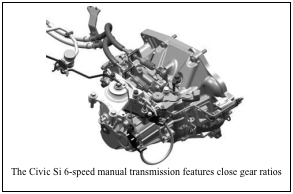
Civic Si: 6-Speed Manual Transmission
To provide driving enthusiasts with exceptional control and feel, the high-performance Civic Si is available exclusively with a short-throw, close-ratio 6-speed manual transmission. The final drive gear ratio for the 2006 model has been reduced 8.5 percent to maximize the engine's torque for quicker acceleration. By employing multiple large-capacity synchronizers (triple cones on 1st and 2nd gears; double cones on 3rd and 4th gears), the 6-speed offers an exceptionally light effort.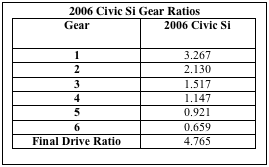
Single cone carbon synchronizers are used on 5th and 6th gears for increased friction capability and reduced shift effort. An extremely short-stroke shift lever provides the quick and precise shift response normally associated with racecar transmissions. Further refining the transmission's sporty, high-quality feel is a short-stroke clutch pedal for quicker shifting, a hydraulic damper integrated with the master cylinder for reduced clutch vibration, and an innovative clutch-friction material for improved clutch engagement feel. Civic Si: Limited Slip Front Differential
Civic Si: Limited Slip Front Differential
The helical type limited slip differential (LSD) in the Civic Si improves acceleration and cornering performance by insuring that both front wheels receive an optimum level of torque at all times. In a straight line, both wheels are better utilized to put the engine's power to the ground with minimal wheel spin. During hard cornering, the LSD transmits more torque toward the outside wheel to bias more power to the tire with the most grip. This also facilitates the outside wheels longer travel distance relative to the inner wheel. Primary benefits include the ability to accelerate harder exiting corners and enhances the vehicle's responsiveness to throttle inputs in corners. Helical means the differential's gear teeth are cut at an angle to the gear's shaft.
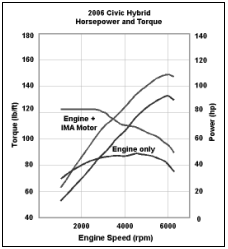 Civic Hybrid Powertrain
Civic Hybrid Powertrain
The fourth generation Honda IMA system consists of a 1.3-liter i-VTEC 4-cylinder engine connected to a high power electric motor and a Continuously Variable Transmission (CVT). A Nickel-Metal Hydride (NiMH) battery pack is used to capture and store electricity for the electric motor. The system uses a gasoline engine as the primary source of power and an electric motor provides additional power and electricity regeneration capability.
During acceleration, the engine or the engine and electric motor propel the vehicle. During cruising, the gasoline engine and/or the electric motor can propel the vehicle. During braking, the gasoline engine deactivates and the electric motor acts as generator to replenish the battery pack. At a stop, the engine can enter an idle stop mode to save fuel and reduce emissions, and the engine is turned off until the brake pedal is released.

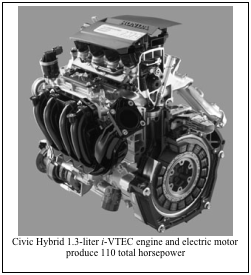 Compared to the 2005 Civic Hybrid with a CVT and AT-PZEV emissions, the 23 percent more powerful 115-horsepower fourth generation Honda IMA powertrain provides stronger starting and overtaking acceleration compared to its predecessor while its city and highway combined EPA estimated fuel economy of 50 mpg provides a maximum driving range over 615 or more miles. The gasoline engine and electric motor combine to produce maximum output of 110 horsepower @ 6000 rpm and 123 lb-ft. of torque @ 2500 rpm.
Compared to the 2005 Civic Hybrid with a CVT and AT-PZEV emissions, the 23 percent more powerful 115-horsepower fourth generation Honda IMA powertrain provides stronger starting and overtaking acceleration compared to its predecessor while its city and highway combined EPA estimated fuel economy of 50 mpg provides a maximum driving range over 615 or more miles. The gasoline engine and electric motor combine to produce maximum output of 110 horsepower @ 6000 rpm and 123 lb-ft. of torque @ 2500 rpm.
The gasoline engine output is rated at 93 horsepower @ 6000 rpm (+ 9 percent) and torque is rated at 89 lb-ft. @ 4500 rpm (+2 percent). The electric motor is designed to provide up to 20 horsepower (+54 percent) @ 2000 rpm and 76 lb-ft. @ 0-1160 rpm of additional torque (+111 percent, similarly equipped).
Civic Hybrid Powertrain At-A-Glance
Engine
- 1.3-liter 3-Stage i-VTEC 4-cylinder engine
- Aluminum block with thin sleeve construction
- Compact single overhead cam (SOHC) 8-valve head with i-VTEC-controlled Variable Cylinder Management (VCM)
- "Intelligent" Dual & Sequential Ignition with two spark plugs per cylinder
- Computer-controlled Programmed Fuel Injection (PGM-FI)
Integrated Motor Assist
- 20 horsepower (15 kilowatt) ultra-thin DC brushless motor
- Intelligent Power Unit (IPU)
- High power nickel metal hybrid battery
- Power Control Unit (PCU)
- Automatic Idle Stop
- Hybrid Dual Scroll Air Conditioner Compressor
Emissions / Fuel Economy
- AT-PZEV Emissions
- Estimated EPA fuel economy of 49/51 (city/highway)
Continuously Variable Transmission
- Wide drive ratio for good low end acceleration and low rpm cruising
- Double piston pulley system
Civic Hybrid: Engine Block Construction, Pistons and Connecting Rods
The aluminum engine block and its internal components create a lightweight package with extremely low friction qualities. To save weight, the block incorporates a thin sleeve construction. Friction reducing measures include plateau honing, low friction pistons, low tensile force piston rings and an offset cylinder bore.
Thin sleeve cylinder wall construction results in a reduction of the total amount of aluminum used in the engine for a lightweight engine block. Plateau honing lowers the friction level between the pistons and the cylinders by creating an ultra smooth surface. Plateau honing is a two stage machining process that uses two grinding processes instead of the more conventional single honing process. This also enhances the long-term wear characteristics of the engine.
Low friction pistons made of aluminum alloy are lightweight and have "micro-dimples" on the cylinder walls for improved lubrication. Offset cylinder bores help minimize friction by positioning the crankshaft axis in a more efficient alignment to the cylinder bore axis. This reduces friction caused by the side thrust of the pistons against the cylinder walls, just after top-dead-center, as each piston begins its descent on the firing stroke.
Connecting rods are high strength forged steel units that have been treated with a special carbon process that hardens the surface and allows engineers to use a design that weighs less than a traditional connecting rod.
Civic Hybrid Cylinder Head: 3-Stage i-VTEC with Variable Cylinder Management (VCM)
The Civic Hybrid uses a 3-Stage i-VTEC valve control system that provides normal valve timing, high output valve timing and cylinder idling functions to the benefit of low fuel consumption, high output and greater electrical regeneration capabilities. The previous generation system in the 2005 Civic Hybrid uses 2-stage VTEC that provides normal valve timing and 3-cylinder idling. The 3-stage system adds high output valve timing and 4-cylinder idling. The high output valve timing contributes to the engines increase in output of 9 percent, while the added cylinder deactivation reduces pumping losses by 66 percent to help improve electrical regeneration capability by 1.7 times.
The Civic Hybrid's single overhead camshaft (SOHC) cylinder head uses a compact chain drive and a compact, low friction VTEC system. It uses a common rocker shaft for both the intake and exhaust rocker arms. Placing all the rocker arms on one shaft eliminates the need for a second rocker-arm shaft, so the valve mechanism can be lighter and more compact. To reduce friction, the rocker arms have rollers built-in.
The compact valvetrain allows for a desirable narrow angle (30-degrees) between the intake and exhaust valves, which helps supply a more powerful direct charge into the cylinder chamber.
The narrow angle valvetrain also allows for a more compact combustion chamber. The intake ports create a swirl effect in the cylinder chamber that promote a well balanced and even air fuel mixture as it enters the engine. This optimizes the air fuel mixture for a cleaner, more efficient combustion.
The new VCM system is an advanced form of the three-cylinder Cylinder Idling System used on the previous generation. VCM allows the regenerative braking system to reclaim as much energy as possible during deceleration, while also allowing the electric motor to propel the vehicle in certain steady state cruising situations.
Since the electric motor, which also acts as an electric generator, is attached directly to the crankshaft of the engine, the engine needs to provide as little resistance as possible during deceleration to allow the generator to produce high levels of electricity and charge the batteries. In a traditional engine, the pumping action of the cylinders will actually provide a moderate amount of resistance, or "engine braking," during deceleration. VCM virtually eliminates that effect.
From a mechanical standpoint, the three stage VTEC switching capabilities are made possible a rocker arm design with three hydraulic circuits that accommodates a) low rpm VTEC switching on each cylinder's intake and exhaust valve and b) high speed switching on the [intake] valve. Three oil passages inside the rocker shaft receive oil from an external spool valve (controlled by the ECU based mostly on throttle and rpm). The oil pressure from one of the three passages activates a combination of push pins inside the rocker arms for each of the intake and exhaust valves. By moving the pins, the intake valve rocker arms can follow one of two lobes on the camshaft (normal or high profile). Or, to deactivate the valves and leave them closed, the pins are pushed in a direction that allow part of the intake and exhaust rocker arms to move with the camshaft and not move the closed valves.

Civic Hybrid: Dual & Sequential Ignition with Twin Plug Sequential Ignition Control
The twin plug sequential ignition control is part of the i-VTEC system and helps facilitate an intense and rapid combustion process in the engine. The ignition control has eight ignition coils that are independently controlled according to a dynamic engine map program. The benefits are more power, less fuel consumption and reduced emissions. Honda's patented twin plug sequential control system is programmed to respond to engine rpm and load conditions. Since the system has eight individual ignition coils, it can manipulate the ignition timing of each iridium-tipped spark plug.
When the air/fuel mixture enters the combustion chamber, the first plug located near the intake port ignites. Shortly thereafter, the second plug located near the exhaust port ignites, accelerating the combustion process by forcing the flame to more rapidly propagate. The spark plugs can also ignite simultaneously under certain circumstances. This process results in a more complete combustion compared to a single plug system.
Civic Hybrid: Drive-by-Wire Throttle Control
An electronic drive-by-wire system helps enhance the driving character of the Civic Hybrid. With smart electronics connecting the throttle pedal to the throttle butterfly valve in the intake manifold, the engine response and IMA operation can be optimized to suit the driving conditions and to better match the driver's expectations. By eliminating the direct throttle cable connection to the engine, the ratio between pedal movement and throttle butterfly movement can be continuously optimized. This adjustable "gain" between throttle and engine is a significant step forward in drivability, which also allows for VCM to cut all cylinders and drive with the electric motor only during some cruising situations. A highly responsive DC motor moves the throttle butterfly position in the intake manifold to change actual throttle position. To establish the current driving conditions, the system monitors pedal position, throttle position, vehicle speed, engine speed, calculated road slope and engine vacuum. This information is then used to define the throttle control sensitivity.
Civic Hybrid: Programmed Fuel Injection (PGM-FI)
The Civic Hybrid is equipped with a Programmed Fuel Injection (PGM-FI) system. The system monitors throttle position, engine temperature, intake-manifold pressure, atmospheric pressure, exhaust-gas oxygen content, and intake-air temperature. It controls fuel delivery by multi-holed injectors mounted in the plastic intake manifold. The ECU also tracks the operation of the engine with position sensors on the crankshaft and camshaft.
Civic Hybrid: Lightweight Composite Resin Intake Manifold Chamber
Upstream from the aluminum intake manifold, the engine's intake manifold chamber is constructed of a composite resin instead of aluminum alloy in order to save weight. The individual pieces that make up the manifold chamber are permanently connected with a vibration welding technique y.
Civic Hybrid: Hybrid Dual Scroll Air Conditioning Compressor
A dual scroll hybrid air conditioning system reduces the load on the gasoline engine by using a combination of engine power and an internal electric motor to drive two air conditioning compressors. These compressors can act independently or together as dictated by the cooling needs of the Civic Hybrid's automatic climate control system.
Under normal conditions, either of the two compressors cools the interior cabin individually depending upon cooling needs and the charge state of the IMA's battery pack. On warmer days, the 75cc engine-mounted compressor acts as the sole source of air-conditioning, while the 15cc motor-driven compressor is in action when the climate control is maintaining a steady temperature or the car is idle-stopped.
Under extreme ambient conditions, cooling is provided by the 75cc belt-driven compressor attached to the engine and the 15cc, 144V motor-driven by an internal electric motor. When the air conditioning system is forced to use both the gasoline engine and electric motor, the Civic Hybrid's idle-stop feature is temporarily disabled until cooling needs are reduced.
Civic Hybrid: Engine Mounts
A new torque rod damper system added to the subframe helps reduce rocking and isolate powertrain NVH from the passenger compartment. Engine mounts, one of which is hydraulic, and reinforcements in the engine compartment help further reduce engine noise and vibrations.
These features significantly reduce vibration and result in a more comfortable ride.
Civic Hybrid: IMA System
The 4th-generation IMA system is the most powerful and most efficient to come out of Honda's hybrid development program. As with previous versions, the IMA system consists of an ultra-thin DC brushless electric motor mounted between the gasoline engine and the continuously variable transmission, and an Intelligent Power Unit (IPU) that stores electric power in a compact battery box and controls the flow of electricity to and from the electric motor.
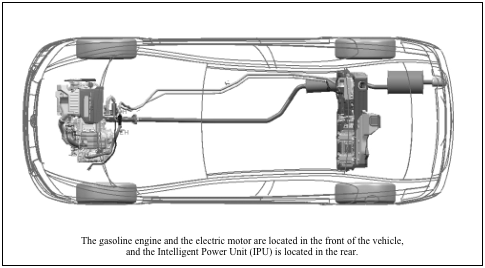
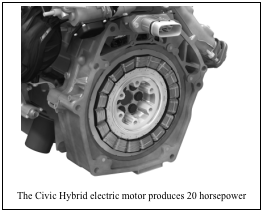 Civic Hybrid: IMA Electric Motor
Civic Hybrid: IMA Electric Motor
Providing supplemental power boost to the 1.3-liter 4-cylinder engine and giving the Civic Hybrid the capability to cruise on its electric motor in certain cruising situations, the IMA's electric motor is designed to provide up to 20 horsepower (15 kW) and 66 lb-ft. of additional torque to the Civic Hybrid's engine. Mounted between the engine and the CVT transmission, the IMA motor is an ultra-thin (70 mm) DC brushless design and provides a substantial amount of low-end torque to aid acceleration, while also assisting in steady-state cruising and hill climbing
In addition to providing supplemental motive power, the IMA motor acts as a generator during deceleration and braking to recapture kinetic energy and recharge the IMA's battery pack during regenerative braking. For this fourth generation of IMA motor, a new internal permanent magnet was designed to increase output density and make the motor more efficient than previous motors. It also uses flat wire construction to increase wire density. The electric motor has increased output horsepower by 50 percent and maximum torque by 14 percent compared with the 2005 Civic Hybrid IMA motor. The electric motor is also more efficient, now converting 96 percent (versus 94.6 percent efficiency of the 2005 Civic Hybrid IMA motor) of the available electricity into motive energy in assist mode.
Civic Hybrid: IMA Intelligent Power Unit (IPU)
Power for the IMA system is controlled through the Civic Hybrid's Intelligent Power Unit. Located directly behind the rear seatback, the IPU consists of the Power Control Unit (PCU) - or the IMA's command center, a rechargeable Nickel Metal-Hydride battery module, and an integrated cooling unit.
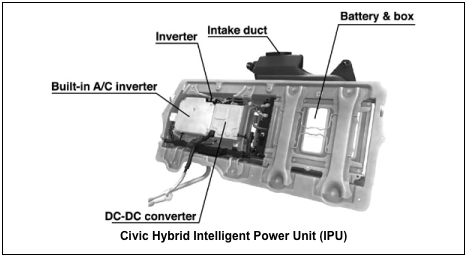

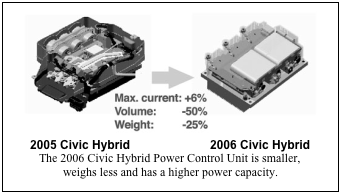
The Power Control Unit (PCU) electronically controls the flow of energy to and from the IMA's electric motor. Using the latest in computer chip technology, the PCU's response time is quickened over previous versions, and a new inverter and DC/DC Converter help contribute to the IMA's overall increase in peak power.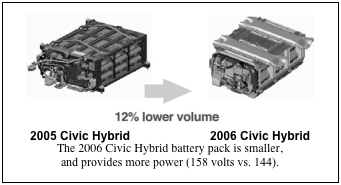
The battery pack stores electricity in a bank of Nickel Metal-Hydride cells. This bank of 132 1.2-volt units stores up to 158 volts of electrical energy for the IMA motor compared to 144 in previous versions. A new Panasonic® dual module casing reduces weight from previous hybrid battery packs and also allows it to increase efficiency of the electrical flow. The 12 percent smaller volume of the battery pack accommodates more cargo space.
The Integrated Cooling Unit offsets the heat generated by the constant flow of electricity to and from the battery pack with an integrated cooling system mounted directly on the battery pack's outer box. Interior cabin air is continually flowed over the battery pack and re-circulated via a small vent placed on the rear seat shelf.
Civic Hybrid: Cooperative Regenerative Brake System
Hybrid-powered vehicles recapture kinetic energy via regenerative braking and store this energy as electricity in rechargeable battery packs. The Civic Hybrid is no different, as its IMA electric motor also acts as a generator that can recharge its battery pack during braking, steady cruising, gentle deceleration, or coasting.
New for 2006, a cooperative regenerative braking system debuts on the Civic Hybrid with the added capability to intelligently proportion braking power between the hydraulic brakes and the electric motor to extract even more electricity from the vehicle's kinetic energy. Less reliance on the traditional braking system and reduced engine pumping losses translate into greater electrical regeneration (170 percent more than the 2005 Civic Hybrid) and ultimately improved fuel economy.
When braking, a brake pedal sensor sends a signal to the vehicle's IMA computer (IPU). The computer activates a servo unit in the brake system's master cylinder that proportions braking power between the traditional hydraulic brakes and the electric motor to maximize regeneration. Previous versions of Honda's IMA systems proportioned braking power at a pre-set rate below the maximum regeneration threshold and with no variable proportioning.
Civic Hybrid: Continuously Variable Transmission
Honda's fourth generation of Continuously Variable Transmission (CVT) is standard equipment on the Civic Hybrid and provides a 9 percent wider range between the maximum and minimum gear ratios to enhance acceleration and minimize engine rpm at high speeds. The transmission provides smooth and predictable transitions and helps keep the IMA system operating at its peak efficiency.
Unlike a conventional transmission with four of five gears that change the final drive ratio in steps, a CVT uses a steel belt and a variable pulley to infinitely change the final drive ratio between a minimum and maximum setting. The variable pulley with its angled internal sides moves in and out by hydraulic pressure to expand or reduce the radius traveled by the steel belt. Improvements to the new CVT include:
- 9 percent wider ratio range of 2.52 - 0.421:1 (previously 2.36 - 0.407:1)
- Final drive ratio of 4.94:1 (previously 5.58:1)
- Expanded pulley axial distance from 143 mm to 156 mm
- Expanded pulley ratio range to 6.0 mm from 5.8 mm
- Double hydraulic piston used on variable pulley increases pressure by 170 percent
- Improved low friction construction for overall efficiency increase
- Torque handling capacity increases by 18 percent
Overall, a CVT provides a fuel economy benefit greater than a conventional automatic transmission with gears, approaching that of a manual transmission. It helps the engine stay in its most efficient operating range for both performance and economy, and the need to shift gears is eliminated.
Civic Sedan and Coupe Powertrain
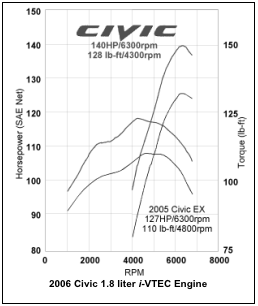 The Civic Sedan and Civic Coupe benefit from a new generation of Honda engine technology that provides performance similar to a 2.0-liter engine and fuel economy similar to a 1.5-liter engine. The new engine offers significantly improved low rpm torque and top end power. A new 5-speed automatic transmission (available) extracts this extra power to its fullest potential. Additional new Civic technology includes a drive-by-wire throttle control and a dual-stage air intake manifold.
The Civic Sedan and Civic Coupe benefit from a new generation of Honda engine technology that provides performance similar to a 2.0-liter engine and fuel economy similar to a 1.5-liter engine. The new engine offers significantly improved low rpm torque and top end power. A new 5-speed automatic transmission (available) extracts this extra power to its fullest potential. Additional new Civic technology includes a drive-by-wire throttle control and a dual-stage air intake manifold.
For 2006, all Civic Sedan and Civic Coupe models are powered by a Single Overhead Cam (SOHC) 1.8-liter inline four-cylinder design with 16 valves, a new version of i-VTEC, and a dual-stage intake manifold. The engine produces 140 horsepower @ 6300 rpm (up from 127 horsepower at 6300 rpm, EX trim level), 128 lb-ft. of torque at 4300 rpm (up from 114 lb-ft. @ 4800 rpm, EX trim level) and an estimated EPA city/highway fuel economy of 30/40 miles per gallon (up from 29/38 miles per gallon on LX with automatic transmission). Emissions in all 50 states are rated as ULEV-2, an improvement from the ULEV-1 emission standard on the 2005 model. The engine performance differences are even greater when compared the 2005 Civic's LX and DX trim levels that produced 115 horsepower @ 6100 rpm and 110 lb-ft. of torque @ 4500 rpm.
Civic Powertrain At-A-Glance
Engine
- High rigidity aluminum block with low friction internal components
- i-VTEC "intelligent" valve control system
- Composite dual stage intake manifold
- Drive-by-wire throttle control
- Programmed Fuel Injection (PGM-FI)
Emissions / Fuel Economy
- Estimated EPA fuel of 30/40 city/highway (automatic transmission)
- Ultra Low Emissions Vehicle-2 (LEV-2)
Transmissions
- Standard 5-speed manual transmission
- Available 5-speed automatic transmission
High Rigidity Aluminum Block and Low Friction Engine Design
Compact, rigid, lightweight and low friction describes the end result of new engine technology that helps to enable the new Civic to achieve high power and high fuel economy. Compared to its predecessor, the aluminum engine block is more compact, has a higher power-to-weight ratio, operates with less internal friction and creates less noise and vibration.
A narrow width cam chain, a chain case with a built-in oil pump and ferrous spin cast cylinder sleeves are used to make the engine approximately 13 mm shorter, allowing for greater packaging efficiency.
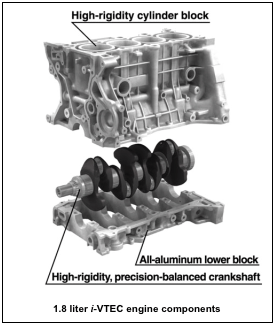 To make the engine more rigid, extensive analysis was used to create reinforced areas in the aluminum block construction. Furthermore, a lightweight and super stiff steel crankshaft is used with a high balance ratio that also benefits from a lower block design with extremely high crank support rigidity. At the very bottom of the engine, an aluminum oil pan with integrated stiffeners further refines the rigidity. The high rigidity block design benefits low noise output and also provides the foundation for lower friction in the engine.
To make the engine more rigid, extensive analysis was used to create reinforced areas in the aluminum block construction. Furthermore, a lightweight and super stiff steel crankshaft is used with a high balance ratio that also benefits from a lower block design with extremely high crank support rigidity. At the very bottom of the engine, an aluminum oil pan with integrated stiffeners further refines the rigidity. The high rigidity block design benefits low noise output and also provides the foundation for lower friction in the engine.
Low friction, a key component to producing more power, is achieved through the application of Molybdenum Di-Sulfide (MoS2) piston coatings and cylinder sleeve plateau honing. Plateau honing lowers the friction level between the pistons and the cylinders by creating an ultra smooth surface. Plateau honing is a two stage machining process that uses two grinding processes instead of the more conventional single honing process. This also enhances the long-term wear characteristics of the engine. A low friction ion plated piston ring further reduces friction. In addition low viscosity oil (5W-20) is used to reduce friction.
Cracked Connecting Rods
High strength cracked connecting rods are used that minimize weight and size, while also increasing connecting rod rigidity and long term durability. A "cracked" connecting means that the rod and cap are forged as a complete unit during the manufacturing process, and then cracked apart to create a custom fit between the two matching surfaces. The use of high strength steel contributes to the connecting rod's slender shape and results in a 50 percent increase in fatigue resistance for a long lasting engine.
The design allows for the elimination of connecting rod bolt pins, since the connecting rod bolts can be precision machined to fit the cap to the rod. The end result is a connecting rod that is 13 percent lighter and has a 20 percent smaller cross section, resulting in less rotating mass inside the engine and less space occupied by the connecting rod - a significant component to creating a powerful, efficient and compact engine.
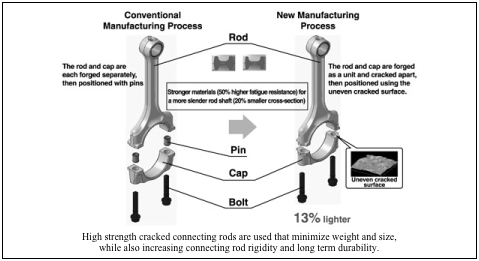
Civic: i-VTEC Valve Control System
 To achieve more performance and more fuel economy, the Civic's 1.8-liter i-VTEC engine uses an innovative and new valve control timing to minimize pumping losses during cruising and low engine load situations, an important factor in creating more efficient engines. Pumping losses are lowered when the variable valve timing allows an intake valve to remain open for a brief time period as the piston begins its compression stroke. By keeping an intake valve open during part of the compression stroke, some of the volume of unburned air/fuel mixture in the cylinder moves back inside the intake manifold and lowers the volume being compressed, or "pumped."
To achieve more performance and more fuel economy, the Civic's 1.8-liter i-VTEC engine uses an innovative and new valve control timing to minimize pumping losses during cruising and low engine load situations, an important factor in creating more efficient engines. Pumping losses are lowered when the variable valve timing allows an intake valve to remain open for a brief time period as the piston begins its compression stroke. By keeping an intake valve open during part of the compression stroke, some of the volume of unburned air/fuel mixture in the cylinder moves back inside the intake manifold and lowers the volume being compressed, or "pumped."
The pumping loss reduction yields enhanced fuel economy similar to an engine with a smaller displacement (the equivalent of a 1.5-liter engine) during cruising.
During cruising or other stable, low-load driving conditions, the new engine utilizes a dedicated set of cams to close one of the intake valves and retard that valve's timing, exerting backpressure on the air-fuel mixture.
This reduces the actual intake air volume. Meanwhile, the throttle is opened wider to provide optimum control over engine output. Opening the throttle valve, in other words, widening the path that the air flows through - reduces pumping losses to result in a significant improvement in engine efficiency.
During high load situations, the VTEC system provides high output valve timing for maximum power. Gone is the normal valve timing, replaced by two fundamentally greater extremes. A dual-stage air intake, a lightweight powertrain and optimized gearing further add to the performance character of the vehicle.
 Whereas traditional VTEC operation changes valve opening duration based on higher oil pressure during high rpm operation at one side of the valvetrain's rocker arms, the Civic's i-VTEC system can switch valve timing duration at low rpm and low oil pressure using two hydraulic actuators on both sides of the intake rocker arm. This engagement method is similar to that used on the Civic Hybrid, Accord Hybrid and Odyssey i-VTEC systems.
Whereas traditional VTEC operation changes valve opening duration based on higher oil pressure during high rpm operation at one side of the valvetrain's rocker arms, the Civic's i-VTEC system can switch valve timing duration at low rpm and low oil pressure using two hydraulic actuators on both sides of the intake rocker arm. This engagement method is similar to that used on the Civic Hybrid, Accord Hybrid and Odyssey i-VTEC systems.
This Civic's i-VTEC valve timing reacts to driving conditions related to throttle opening, vehicle speed, engine rpm and gear selection. A sophisticated drive-by-wire throttle control, air flow meter and dual-stage air intake allow the Engine Control Unit (ECU) to create seamless transitions between the two modes of engine operation.
Civic: Lightweight Composite Intake Manifold Chamber
The engine's intake manifold chamber is constructed of composite resin instead of aluminum alloy in order to save weight. The individual pieces that make up the manifold chamber are permanently connected with a die-slide welding technique.
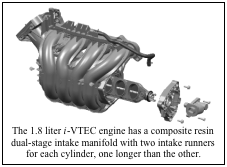 Civic: Composite Resin Dual Stage Air Intake Manifold
Civic: Composite Resin Dual Stage Air Intake Manifold
A composite resin dual-stage intake manifold utilizes two intake runners for each cylinder, one longer than the other. Below 5200 rpm, only the longer of the two runners delivers air to the cylinder-taking advantage of the inertia effect of the long intake path. Above 5200 rpm, however, a rotary valve in the bore of the short runner opens to allow the passage of additional air to the cylinder. This has the effect of boosting midrange and high-rpm power by utilizing the inertia effect at both low and high rpm.
Civic: Drive-by-Wire Throttle Control
An electronic drive-by-wire system helps enhance the driving character of the Civic. With smart electronics connecting the throttle pedal to the throttle butterfly valve in the intake system, the engine response can be optimized to suit the driving conditions and to better match the driver's expectations. Combined with the dual stage air intake, the drive-by-wire throttle control system is an important component to the new i-VTEC system that makes switching between the low pumping loss mode and the high performance mode seamless to the driver. By eliminating the direct throttle cable connection to the engine, the ratio between pedal movement and throttle butterfly movement can be continuously optimized. This adjustable "gain" between throttle and engine is a significant step forward in drivability. A highly responsive DC motor moves the throttle butterfly position in the intake system to change actual throttle position. To establish the current driving conditions, the system monitors pedal position, throttle valve opening position, vehicle speed, engine speed, and engine vacuum. This information is then used to define the throttle control sensitivity.
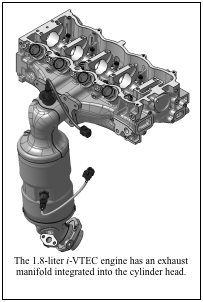 The throttle system also works to enhance the available 5-speed automatic transmission's ability to make shifts faster and smoother. By coordinating the throttle opening with the transmission's shifting functions, engine power can be precisely tailored to the needs of the transmission at every point during the shifting process. That means less shift shock and delay, no matter the driving situation.
The throttle system also works to enhance the available 5-speed automatic transmission's ability to make shifts faster and smoother. By coordinating the throttle opening with the transmission's shifting functions, engine power can be precisely tailored to the needs of the transmission at every point during the shifting process. That means less shift shock and delay, no matter the driving situation.
Civic: Exhaust System
The Civic is equipped with a stainless steel, low heat-mass exhaust system integrated into the cylinder head that eliminates the need for a separate exhaust manifold, contributing to the engine's compact design and light weight. The system employs a high-density catalytic converter for improved light-off performance and reduced hydrocarbons and NOx. For emissions performance, the exhaust manifold is positioned on the front of the engine-which shortens the distance that the exhaust gases must travel to the catalytic converter, resulting in faster light-off and more complete conversion of the exhaust gases.
Civic: Maintenance Minder and Tune-Up Intervals
The Civic's engine tune-up schedule is calculated by the Maintenance Minder system. The Maintenance Minder system automatically indicates when to have standard service performed based on actual driving conditions (tracked by the ECU) and minimizes the guesswork related to whether the vehicle is being used in standard or severe use conditions for maintenance interval purposes. The display indicates when to change the oil, air cleaner, transmission fluid, spark plugs or coolant, as well as when to rotate the tires. Under normal usage, a tune-up is not required until typically more than 100,000 miles (only routine inspections and fluid changes are required up to this point). Credit for this longevity goes to long-wearing iridium spark plugs, a long-life timing chain, and careful engineering of the precisely manufactured SOHC valvetrain-which reliably maintains proper valve tappet clearances until the first tune-up.
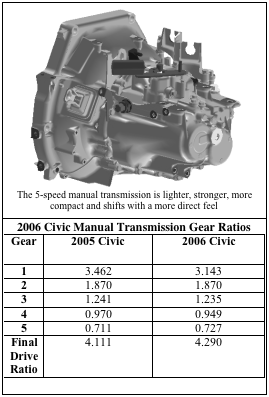 Civic: 5-Speed Manual Transmission
Civic: 5-Speed Manual Transmission
The 5-speed manual transmission has also been redesigned into a more lightweight and compact unit that minimizes power-robbing rotating mass and adds a rotating select link for quick and direct gear changes. Additional features include a low friction design with single cone synchronizers in all gears and high capacity bearings throughout. From a performance standpoint, the new manual transmission has a higher torque capacity and a shorter, firmer and more direct shift feel.
Civic: 5-Speed Automatic Transmission
The Civic Sedan and Civic Coupe are available with an electronically controlled 5-speed automatic transmission. The 5-speed automatic transmission - a first for the Civic - is all new for 2006 and improves on the previous 4-speed automatic design with a wider overall ratio that maximizes acceleration in gears one through four and optimizes fuel economy in its overdrive fifth gear. The computer controlled direct control transmission provides amazingly smooth shifts.
The direct control coupled with gear ratios that are closely matched to the output of the engine help extract more power from the engine at just the right time to provide overall vehicle performance competitive to vehicles with 4-speed automatic transmissions and more horsepower.
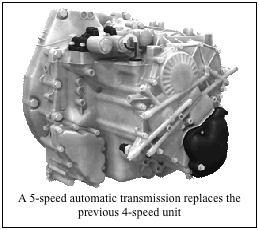 The 5-speed automatic transmission uses a wide variety of technology that provides smoother shifting as well as reduced friction for enhanced efficiency. Those technologies include a low-friction clutch and a special super-thin torque converter. The thin torque converter results in a compact transmission unit. Other space saving measures include a double-row idle gear and a tightly packaged second-gear clutch.
The 5-speed automatic transmission uses a wide variety of technology that provides smoother shifting as well as reduced friction for enhanced efficiency. Those technologies include a low-friction clutch and a special super-thin torque converter. The thin torque converter results in a compact transmission unit. Other space saving measures include a double-row idle gear and a tightly packaged second-gear clutch.
To improve powertrain smoothness and reduce gear "hunting" on steep grades, the 5-speed automatic transmission is also equipped with a standard Grade Logic Control system. Using sensors that monitor throttle position, vehicle speed, and acceleration/deceleration and then comparing these inputs with a map stored in the transmission computer, the system is able to determine when the vehicle is on an incline and adjust the shift schedule for improved climbing power or downhill engine braking. To improve fuel economy while maintaining a high level of drivability, the 5-speed automatic transmission includes an active lockup torque converter. With the precise control afforded by a linear solenoid, the system expands the speed and throttle setting range in which lockup can be engaged.
To improve fuel economy while maintaining a high level of drivability, the 5-speed automatic transmission includes an active lockup torque converter. With the precise control afforded by a linear solenoid, the system expands the speed and throttle setting range in which lockup can be engaged.